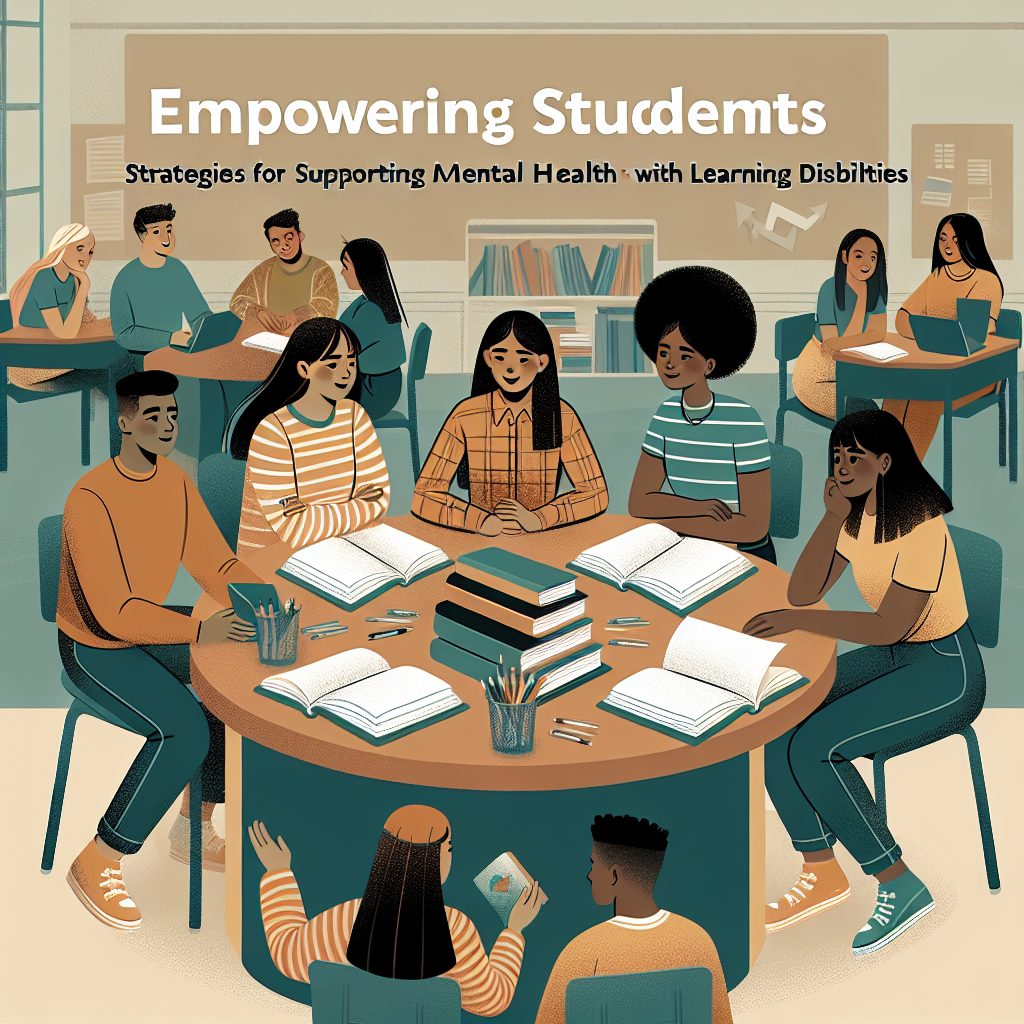
Empowering Students: Essential Strategies for Supporting Mental Health in Those with Learning Disabilities
Introduction
In an era where mental health awareness is at the forefront of educational discussions, the need to address the unique challenges faced by students with learning disabilities has never been more pressing. These students often experience a dual challenge: grappling with their learning differences while simultaneously navigating the complexities of emotional and mental health. Empowering students: strategies for supporting mental health in those with learning disabilities is not just a concept; it’s a fundamental necessity that calls for immediate attention from educators, parents, and policymakers alike.
Consider the story of Sarah, a vibrant student diagnosed with dyslexia. Sarah loves to read, but her difficulties with written language often leave her feeling isolated and inadequate compared to her peers. While traditional academic settings can foster her love for literature, they can equally contribute to her anxiety and self-doubt. By implementing effective strategies to support her mental health, we not only help Sarah thrive academically but also promote her overall well-being.
In this article, we will explore practical and evidence-based strategies that empower students like Sarah, ensuring they have the mental health support they need to flourish in and out of the classroom.
Understanding Learning Disabilities and Mental Health
The Intersection of Learning Disabilities and Mental Health
Learning disabilities encompass a range of cognitive impairments that hinder a person’s ability to process information, and they can drastically affect self-esteem and emotional well-being. Research shows that students with learning disabilities are at an increased risk of experiencing mental health issues, including anxiety disorders and depression. Identifying signs of these mental health challenges early on is crucial; this can empower educators and families to implement timely interventions.
Case Study: John’s Journey
John, a high school student with ADHD, faced significant challenges with organization and focus. Initially, John’s struggles were dismissed as mere laziness, leading to feelings of frustration and inadequacy. However, his teachers discovered that he thrived in a structured environment with clear expectations. By employing organizational tools and offering emotional support, they transformed his academic path. John began to excel and regained his confidence, showcasing how understanding individual needs can lead to positive outcomes.
The Role of Educators and Parents
Educators and parents play a vital role in recognizing and addressing the mental health of students with learning disabilities. Open lines of communication build trust, while a supportive home-school partnership can enhance the effectiveness of any strategy implemented.
Strategies for Supporting Mental Health
1. Creating an Inclusive Classroom Environment
- Fostering a Growth Mindset: Encouraging students to view challenges as opportunities for growth can significantly reduce anxiety and improve resilience.
- Peer Support Programs: Implementing buddy systems allows students to connect with peers who understand their experiences, fostering community and reducing isolation.
Table 1: Benefits of an Inclusive Classroom
| Benefit | Description |
|---|---|
| Enhanced Social Skills | Promotes interaction and communication. |
| Improved Academic Performance | Encourages engagement and participation. |
| Increased Self-Esteem | Validates student experiences and abilities. |
2. Tailoring Instructional Methods
- Differentiated Instruction: Adjust teaching methods to cater to various learning preferences, providing multiple ways to engage with content.
- Assistive Technology: Incorporating tools like speech-to-text software can empower students, allowing them to express themselves without the pressure of traditional writing challenges.
3. Prioritizing Mental Health Awareness
- Mental Health Education: Teaching students about mental health can reduce stigma and promote help-seeking behaviors. Workshops that include coping strategies empower students to manage their emotions.
Case Study: Emily’s Transformation
Emily, a fourth-grader with a learning disability, participated in a mental health workshop at her school. The program educated students about emotional regulation and coping strategies, which helped Emily recognize her anxiety triggers. With this newfound knowledge, she developed mechanisms to handle stressful situations, a testament to the importance of mental health education.
4. Encouraging Open Dialogues About Feelings
- Creating Safe Spaces: Providing spaces where students feel comfortable expressing themselves without judgment can encourage them to talk about their feelings, fears, and successes.
5. Involving School Counselors
- Support Services: Collaborating with school mental health professionals can provide students with additional support systems that address both academic and emotional needs.
Monitoring Progress and Making Adjustments
Regular Check-ins
Establishing regular check-ins with students to discuss their academic and emotional well-being helps educators identify any concerns early.
Collaboration with Mental Health Professionals
Partnering with mental health professionals for ongoing support can enhance the effectiveness of classroom strategies and help tailor interventions to individual student needs.
Conclusion
Empowering students: strategies for supporting mental health in those with learning disabilities is a shared responsibility that requires a collaborative approach. By prioritizing mental health and implementing varied instructional strategies, we can create a nurturing environment where students with learning disabilities can flourish. It’s about giving them the tools they need—emotionally and academically—to succeed.
Let us be the advocates for change by prioritizing mental health support, fostering inclusive environments, and always advocating for our students’ voices to be heard. Together, we can rewrite the narrative of learning disabilities by showing that with the right support, every student can achieve their fullest potential.
FAQs
1. What are learning disabilities?
Learning disabilities are neurological conditions that affect how individuals process information and learn, impacting skills like reading, writing, and mathematics.
2. How prevalent are mental health issues among students with learning disabilities?
Research indicates that students with learning disabilities are two to three times more likely to experience mental health issues compared to their peers.
3. What role does emotional support play in education?
Emotional support fosters resilience, encourages positive mental health, and enhances academic performance, making it fundamental for students with learning disabilities.
4. How can parents advocate for their child’s mental health?
Parents can work collaboratively with schools, attend mental health workshops, and ensure consistent communication with teachers about their child’s needs.
5. What are effective coping strategies for students experiencing anxiety related to learning disabilities?
Some effective coping strategies include mindfulness exercises, organizational tools, and seeking support from teachers or counselors when needed.
6. How can schools implement mental health education?
Schools can implement mental health education through curricula, workshops, and peer-led initiatives that foster open conversations about mental health.
By utilizing these insights and strategies, we can fortify an educational landscape where all students, including those with learning disabilities, feel empowered, understood, and fully capable of achieving their dreams.
















